Famous places to visit in Agra
01 Taj Mahal

The designs of this structure incorporate Persian and Mughal architecture. The highlight of the structure is the tomb which is a large structure made completely of marble. There is a dome made of marble that surmounts this region. It is spectacularly designed.
The exterior decorations are as impressive as the interiors and are consistent with the surface area and the proportionality of the designs is meticulously planned and executed. Paint was the chief constituent for the decorations.
In accordance with the Islamic doctrine prohibition, there are no anthropomorphic forms anywhere in the design scheme. There are multiple verses from the Qur’an used inside the complex.
The interior chamber is impressively decorated with precious and semiprecious gemstones. Geometrically shaped as an octagon, this space has multiple entry points. After you have visited the interiors, experience the salubrious gardens of the Taj Mahal when on a tour of places to see in Agra.
The complex is surrounded by well-kept gardens and there is a marble water tank in the middle. You can find neatly lined avenues of trees. There are plenty of fountains that are lined in order as well.
Located in Agra, the magnificent monument is open from sunrise to sunset and closed to the public on Fridays. The mosque inside the Taj is open for prayers though. Visiting this place is a beautiful and romantic experience.
02 Agra Fort
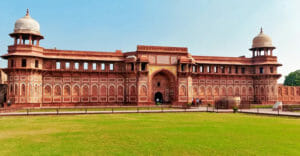
Also called the Red Fort, this structure dates back to the 16th century. It is situated near the gardens of the Taj Mahal. Made of red sandstone, Agra Fort has walls that surround for at least two kilometers and more. Inside are many splendid palaces such as Jahangir Palace and Khas Palace. It is over here that you will find the grand hall of audiences called Diwan-i-Khas. Also on location are a couple of magnificent mosques.
The Red Fort, like the Taj Mahal, is an ode to the rich legacy of the Mughals. These structures indicate the glorious past that existed during the medieval period, and must form part of any itinerary of places to visit in Agra.
The Agra Fort was built in 1565 under the aegis of Akbar. Situated on the right bank of the Yamuna River, this fort and the Taj form a unity of monuments. Both structures complement each other given that they are in the same vicinity. You can enter the fort through the Delhi or Amar Singh Gates. The bigger entrance is the former. As you go in the fort complex through the Delhi gate, you approach the inner portal. Also called the Hathi Pol this entrance is a magnificent one.
Inside the tower, you would be amazed at the Muhammad Burj which is an octagonal spire. The Shish Mahal is in this complex where you see some splendid reception rooms. The complex is beautifully constructed and palatial. The two mosques within this mosque are built of white marble.
The Moti Masjid and Nagina Masjid are the two mosques that leave you spellbound with their structural beauty. These mosques were built under the aegis of Aurangzeb. The whole complex has intricate carvings and most structures inside are made of pure marble. The influence of Indo-Muslim art is strong in these surroundings.
03 Jama Masjid

Of places to visit in Agra, the Jama Masjid is a magnificent structure. The original name of this construct was Masjid Jahan Numa. Built by Shah Jahan, the very best of artisans, sculptors, engineers and thousands of labourers were used in the construction effort.
For six years, all these people toiled continuously to build the Jama Masjid. The cost of construction of this structure was a million rupees. It is believed that several stones and construction items were gifted by nobles. The verses of the Holy Quran were recited before consecrating and laying down of each stone.
The Jama Masjid is essentially a mosque situated in bustling market of Chandni Chowk. The design is simple yet extremely artistic. At any given point of time the mosque can accommodate more than 25,000 people.
The mosque in total has four towers and there are three gateways to this place of worship. You can see two tall minarets of about 40 metres in height flanking the structure. The Agra Fort is on the Eastern side of the mosque.
The main prayer hall is articulately laid and the entrance to this space is decorated with high arches with cusps adorning them. You must visit the courtyard during special ceremonies, it is packed with devotees. You will be amazed at the strength of the congregation in one of the most beautiful mosques in the world.
Although you don’t pay for entrance, you have to pay for taking photographs. Visit the cupboard encloses ancient relics in the mosque that lies in the vicinity of the North Gate. Apart from artefacts see verses of the Holy Quran inscribed on deer skin. The Jama Masjid is located in Chandni Chowk area of Delhi. It is open on all days of the week except on Fridays.
04 Fatehpur Sikri
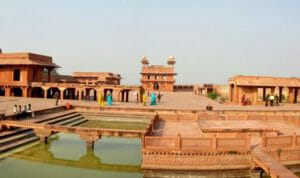
This is a historic city among the places to visit near Agra. The city was founded by Akbar who was a powerful Mughal emperor. Fatehpur Sikri was the capital city of the Mughal Empire for many years before Agra took this position. Akbar was instrumental in envisioning the city. He commissioned the building of gardens, harems, planned roads, mosques, and utility structures.
05 Itmad-ud-Daulah’s Tomb
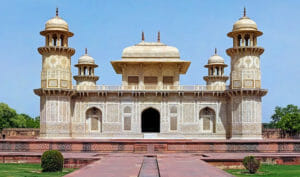
This is a Mughal mausoleum known for its monumental architecture. The tomb has been built with red sandstone. This is one of the famous tourist places in Agra which is located in Uttar Pradesh.
Sometimes this structure is called Baby Taj colloquially. The interiors of the Itmad-ud-Daulah’s tomb have many facets that resemble the interiors of the Taj Mahal. Along with the main building, there are several buildings outside the complex. There are beautiful gardens that dot the landscape as well.
In the initial phase of its construction, the designs were made on marble based concrete. The subsequent phases incorporated the design characteristics of the Taj Mahal. Nur Jahan oversaw the building of the mausoleum. She was the better half of the Mughal ruler Jahangir. The tomb was for her father Mirz? Ghiy?s Beg.
The tomb is located on the banks of the Yamuna River. The structure is surrounded by a garden. There are water courses and walkways in the vicinity. Hexagonal towers flank the structure on its corners. The white marble used in construction has been procured from Rajasthan.
The designs are elaborate and intricate. The inside of the tomb is well-lit by natural light. Jail screens allow light to pass through. Not just Nur Jahan’s father, but many of her relatives have been buried here.
Itmad-ud-Daulah is remembered to this date for its architecture. It represents a glorious chapter of India’s history when the Mughals ruled the land. Their sense of aesthetics and architecture is astounding. Overlooking the Yamuna River, this mausoleum is an architectural marvel. It befits the tag of being called the miniature version of the Taj Mahal.
When you visit this place, walk around the tranquil gardens. Experience the freshness of these verdant settings in one of the most picturesque places to visit in Agra. Feel like you are living in a bygone era.
06 Akbar’s Tomb
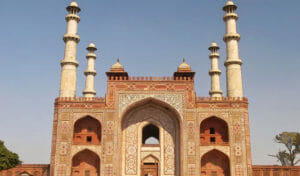
This tomb is yet another masterpiece from the Mughal period. Akbar’s Tomb resides in more than 119 acres of land. Located in the grounds of Sikandra, Akbar himself started this construction 1600. As per the Tartary custom, it was a practice during that time to commission the construction of one’s tomb when alive. The construction of the tomb was completed by this son Jahangir.
Located in the suburbs of Agra, the tomb is only a stone’s throw away from Mariam’s tomb. Surrounded by high walls, the building is four-tiered and pyramidical in shape. The top of the tomb is made of marble. This is the false tomb as the real one is at the basement. The false tomb is essentially a marble pavilion.
The entry is through the South gate and is flanked by four minarets. These white minarets are similar to the ones found in the Taj Mahal. The structure is constructed using red sandstone. The deep red variety has been used and this aspect of the sandstone material gives a unique texture to the structure.
The panels that have been inlaid into the tomb are decorated with intricate carvings. The designs of the panel have different geometric shapes with some of the being floral. Some parts of the design have calligraphic designs.
There is a scheme behind the construction of this tomb amongst interesting tourist places in Agra. The Charbagh area is segregated into quadrant shaped spaces. Watercourses make this separation. This aspect replicates the Behistan concept in which the tomb is placed at the centre of the garden. The gallery is supported by massive pillars.
07 Moti Masjid
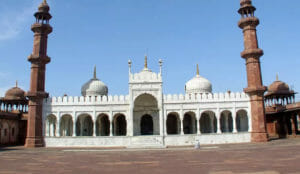
Built by Shah Jahan, the Moti Masjid is also called the Pearl Mosque. It is one of the architectural wonders in Agra. The reason it is called the Pearl Mosque is that it radiates like a pearl especially when the sun is shining bright. The mosque was exclusively built by the emperor for his royal court members. The mosque was built between the years 1648 and 1654. It stands on a sloping ground.
The pearly white insides of the mosque are enthralling to the eye. In the centre of the court is situated a marble tank. There is also a sundial made of a marble pillar and octagonal shaped in the vicinity. The main entrance is located to the East of the structure. It is huge and opens up to a better view of the mosque than the other gates.
The large prayer chamber is flanked by multiple arches. There are 21 bays inside the prayer chamber and some of them have vaulted soffits. The Western wall is the one that intrigues the most. The beautiful carvings on this wall leave you spellbound. There are even prayer halls for women at the Moti Masjid. This space is separated from the main hall. A marble screen separates the women’s prayer chamber from the rest.
Some people are of the opinion that some architectural aspects of this mosque resemble that of Moscow’s St Basils Cathedral. Located on the banks of the Yamuna River, the view from this mosque is simply amazing and is one of the best views amongst places to visit in Agra. To the right of this mosque is the famous Diwan-e-Aam.
08 Sikandra Fort
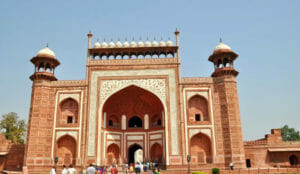
The tomb of Akbar is located inside the Sikandra Fort. A beautifully architected structure, it is made of deep red sandstone. The richness of the look and feel never fades away and is timeless. The tomb is located in Agra in a place called Sikandra. The fort and the tomb are excellent expositions of the combination of Hindu and Muslim architecture.
The fort stands amidst a lush garden which is enclosed in four high walls. Each side of the wall has a colossal gate. The garden is portioned into four distinct spaces. This is in accordance with the Charbagh plan that existed during that time to landscape gardens. The garden has plenty of fountains. There are numerous water channels passing through the garden. Paved causeways provide visitors a unique pathway to walk and experience the excellence of architecture all around.
Sikandra Fort is well-preserved and is among the top tourist places in Agra. When you visit this place you cannot deny the richness of the artistry on display. It is said that Akbar personally designed this fort. Many if not all elements of the fort’s design are a reflection of his personality and his taste in architecture.
The tomb resides on an elevated pyramid. This structure is five storeyed. The internal carvings are intricate and a tribute to great craftsmanship. The marble work inlaid into the tomb’s complex is perfectly exquisite.
The gateways of the fort are magnificent as well. These gates are made of sandstone and there are four of them. All gates lead to the complex and the Southern gate is the one that leads to Akbar’s mausoleum. This place is abuzz with visitors who enjoy the views around. Visiting this tomb complex once is not enough to detail the complete craftsmanship that exists here.
Other places to visit
09 Jodha Bai ka Rauza
This is the palace of one of Akbar’s queens who was his favourite. Also called Jodha Bai’s Palace it is a simple yet sophisticated building. It is situated in the vicinity of the Jahangiri Mahal.
This is the palace of one of Akbar’s queens who was his favourite. Also called Jodha Bai’s Palace it is a simple yet sophisticated building. It is situated in the vicinity of the Jahangiri Mahal.
Inside the palace, there are slits in the wall. You can see the Taj Mahal through these small openings in the wall. The architectural design of this palace incorporated Rajasthani and Gujarati designs. Located in Fatehpur Sikri, this palace is yet another example of Akbar’s strong taste and talent in architecture.
There are some aspects of the Jodha Bai ka Rauza that have resemblances to Hindu architecture. In fact many facets of this structure combined the finest details of Hindu and Muslim architectural designs. This place is guarded by a portal. Here were the residences of Akbar’s favourite queen. It is said that Jodha Bai was the third queen of the emperor.
Also called the Marium Uz Zamani Palace, the queen was actually a Rajput princess. The design of the spaces here has been made in keeping with the taste of ladies. Hence you find that the designs here are simple and elegant. When you peer up, you see the triangular shaped ceiling.
There are plenty of mural designs such as peacocks, elephants, lotus, and ghant mala. All these are Hindu designs. This indicates the religious harmony that existed in Akbar’s period and how people appreciated each other’s culture.
There are plenty of hotels around this palace for tourists looking for places to visit in Agra. You can find hotels suiting various economies here. Jodha Bai’s Palace is an important monument in the imperial harem regime of the Mughals.
It showcased their taste in aesthetics and how they treated their ladies. The architectural style of this palace combines several architectures. The fusion of multiple designs makes this palace an exciting structure to view and photograph.
10 Mehtab Bagh
This is a garden complex located in the vicnity of the Taj Mahal and Agra Fort. Located in Agra and on the banks of the Yamuna River, Mehtab Bagh is a Charbagh planned garden. The spaces inside the garden are equally portioned into separations. The square shaped picturesque land measures exactly 300 x 300 metres.
This is a garden complex located in the vicnity of the Taj Mahal and Agra Fort. Located in Agra and on the banks of the Yamuna River, Mehtab Bagh is a Charbagh planned garden. The spaces inside the garden are equally portioned into separations. The square shaped picturesque land measures exactly 300 x 300 metres.
There were several gardens built on the banks of the river during the Mughal regime in all the places to visit in Agra. This one was the last of them. It is believed that this garden was built under the aegis of Babur.
The garden was first envisioned by Shah Jahan. He selected an ideal spot for viewing the Yamuna River. He wanted a pleasure garden lit by the soft rays of the moon. Hence he named this garden Mehtab Bagh. There are plenty of pools and pavillions in the garden. The walkways are covered with white plaster. There are plenty of fruit trees here.
The garden was made as an extension of the gardens in the Taj Mahal. The idea here was to make a moonlit garden. At night the pools here reflect the view of the Taj Mahal. When Shah Jahan wanted the Mehtab Bagh, he wanted the garden exclusively for himself. He wanted to watch the reflections of the Taj in the water pools and also enjoy the view of the Yamuna River.
The garden is now a horticultural delight. There are scores of plant species here. The Mehtab Bagh has been periodically restored by the Archaeological Survey. You can reach this garden on either side of the river. You can take a ferry ride for a few minutes from the Taj Mahal’s Eastern side to reach this garden. Experience a wonderful creation of imagination put into reality at the Mehtab Bagh.
11 Mother Teresa’s Missionaries of Charity
Mother Teresa’s Missionaries of CharitySend Enquiry
The Missionaries of Charity centre in Agra is a branch of the Missionaries of Charity in Kolkata. Mother Teresa is one of the prominent saints who devoted her life to charity and the development of under-privileged sections of the society.
Mother Teresa’s Missionaries of CharitySend Enquiry
The Missionaries of Charity centre in Agra is a branch of the Missionaries of Charity in Kolkata. Mother Teresa is one of the prominent saints who devoted her life to charity and the development of under-privileged sections of the society.
Be it the sick, orphaned or the diseased, such helpless people always received a helping hand from her. At the time of her passing away, her charity foundation was spread across more than a hundred countries. As part of the charity initiative, several hospitals, schools, nursing homes and counselling programs were set up.
The Agra centre also espouses this collective ideology and is one of the places to visit in Agra. When you visit the centre here you have an opportunity to do God’s work. You can adopt a child, provide education to someone, or simply lend a helping hand to solve someone’s pain. The mission relies on donations made by people. It is a non-profit organisation and a noble one. It is truly a great thing to know that this mission is located in Agra.
12 Wildlife SOS
This is an animal rescue and development organisation located in Agra. Established in 1995, Wildlife SOS actively works towards conservation of wildlife and protecting the natural habitat of wild animals. The organisation also conducts research in preserving biodiversity and creating livelihood means for poachers who rely on killing animals to make a living.
This is an animal rescue and development organisation located in Agra. Established in 1995, Wildlife SOS actively works towards conservation of wildlife and protecting the natural habitat of wild animals. The organisation also conducts research in preserving biodiversity and creating livelihood means for poachers who rely on killing animals to make a living.
This organisation came at a time when India’s wildlife was under threat due to rapid urbanisation. It covers all type of wild animals including elephants and sloth bears, to the majestic tiger. Given that this is a non-profit charity organisation, Wildlife SOS relies on donations from the public.
If you are an animal lover, you can visit this place to make a difference. Your patronage is appreciated and you will be in the company of like-minded people when visiting places to see in Agra.
No comments:
Post a Comment